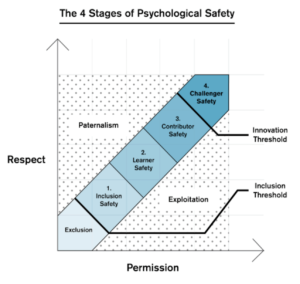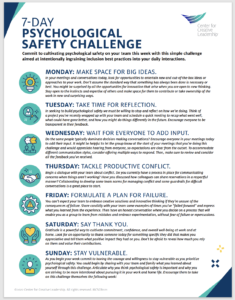
“Failure of an employee to speak up in a crucial moment cannot be seen. This is true whether that employee is on the front lines of customer service or sitting next to you in the executive board room. And because not offering an idea is an invisible act, it’s hard to engage in real-time course correction. This means that psychologically safe workplaces have a powerful advantage in competitive industries.” – Amy C. Edmondson, The Fearless Organization: Creating Psychological Safety in the Workplace for Learning, Innovation, and Growth
I love sharing leadership frameworks when they provide structure and pathways for decision making, vision work, change management and stakeholder mapping, just to name a few.
What I love about the Psychological Safety concept and framework is that it is a foundational framework that all other leadership frameworks can be layered upon. It is so integral to leading, particularly now, and I am so excited to explore it with you and talk about the many ways, “that psychologically safe workplaces have a powerful advantage in competitive industries,” as Dr. Amy Edmondson so poignantly stated in her book quoted above. She coined the term Psychological Safety several years ago.
Introduction to Psychological Safety at Work
Often the work on Psychological Safety focuses on the leaders’ responsibility for making sure those they lead feel psychological safety is valued on the team. But what if leaders themselves don’t experience Psychological Safety? It is something that must penetrate all levels of an organization to truly shift the paradigm of the company culture to one where, David Altman from Center for Creative Leadership describes, “people feel comfortable being themselves. They bring their full selves to work and feel okay laying all of themselves on the line.” Edmondson builds on this idea by emphasizing how important it is people are allowed to voice half-finished thoughts, ask questions out of left field, and brainstorm out loud in order to create a culture that truly innovates. It its most basic form, Psychological Safety is a core value held by a team or organization that means others won’t embarrass, reject or punish a team member for speaking up.
The Four Stages Model
Dr. Timothy Clark the author and CEO of LeaderFactor, a global leadership consulting and training organization, has expanded on Dr. Edmonson’s work and built the framework below that encompasses four stages: sense of inclusion, safety to learn, safety to contribute and safety to challenge.
This is a progressive model and employees have to move up through the four stages before they feel safe enough to make valuable sustainable contributions that challenge the status quo.
Overview of The Four Stages According to Dr. Clark’s Model
Stage 1 – Inclusion Safety: Inclusion safety satisfies the basic human need to connect and belong. In this stage, you feel safe to be yourself and are accepted for who you are, including your unique attributes and defining characteristics.
Stage 2 – Learner Safety: Learner safety satisfies the need to learn and grow. In this stage, you feel safe to exchange in the learning process, by asking questions, giving and receiving feedback, experimenting, and making mistakes.
Stage 3 – Contributor Safety: Contributor safety satisfies the need to make a difference. You feel safe to use your skills and abilities to make a meaningful contribution.
Stage 4 – Challenger Safety: Challenger safety satisfies the need to make things better. You feel safe to speak up and challenge the status quo when you think there’s an opportunity to change or improve.
 The framework has Respect and Permission on the two axes. Respect relates to how the team values and appreciates another team member or leader. Permission is the degree to which the team and leader allow a person to participate and influence group decisions and direction.
The framework has Respect and Permission on the two axes. Respect relates to how the team values and appreciates another team member or leader. Permission is the degree to which the team and leader allow a person to participate and influence group decisions and direction.
According to this framework, Paternalism and Exploitation are called Psychological Safety Gutters. These gutters are traps that occur when the balance between respect and permission are off-kilter. For example, when a leader may grant a person respect but no permission, the person may fall into the gutter of paternalism which also usually means they are being micro-managed.
The Innovation and Inclusion thresholds are progressive. For someone to pass the inclusion threshold it means there is respect for their humanity and acceptance onto the team but it does not mean they are included. Inclusion only happens after the Contributor Safety level is met and there is an invitation for this person to step fully into their assigned role and bring all of themselves to the table.
Leaders need to first help themselves, and ultimately their team, feel comfortable with interpersonal risk-taking by nurturing the sense of Psychological Safety in the workplace.
How to Create More Psychological Safety at Work
There are many tools and questions to facilitate fortifying your leadership to support a workplace rich in psychological safety. One of the best tools I have found is from the Center for Creative Leadership and it is a quick 7-Day Psychological Safety Challenge. I love it for its simplicity and its power to shift culture one day at a time.

I believe today’s leaders’ ability to foster Psychological Safety for themselves, and create a culture of safety for their teams, is paramount to leading effectively. As Amy Edmondson writes, “A 2017 Gallup poll found that only 3 in 10 employees strongly agree with the statement that their opinions count at work. Gallup calculated that by “moving that ratio to six in 10 employees, organizations could realize a 27 percent reduction in turnover, a 40 percent reduction in safety incidents and a 12 percent increase in productivity.” That’s why it’s not enough for organizations to simply hire talent.”
Amy Edmondson describes perfectly why it matters to the health of our organizations and our bottom line in the quote above. What is poignant about making sure people know their opinions count, is that if they believe that, if leaders believe that, it means there is a culture of Psychological Safety where humans can bring their best selves to work and beyond. As a leader you are not just building a foundation of Psychological Safety, you are building a platform to fuel both your growth and the development of all those you lead. It is integral to the success of the business because it matters most to the people doing the work. The perfect place to start this journey as a leader is to ask yourself one question, “How do I react when people make mistakes on my team?”
Inherent in creating an environment where individuals feel psychologically safe, is a greater sense of accountability to one another. Community and shared responsibility for outcomes are natural byproducts of building a culture of Psychological Safety. Can you imagine if leaders the world over started with this foundation? It is ‘safe’ to say our global community would look very different. It is a hopeful framework but it does not need to be aspirational. All the tools are at our fingertips to begin today.
Leave a Reply